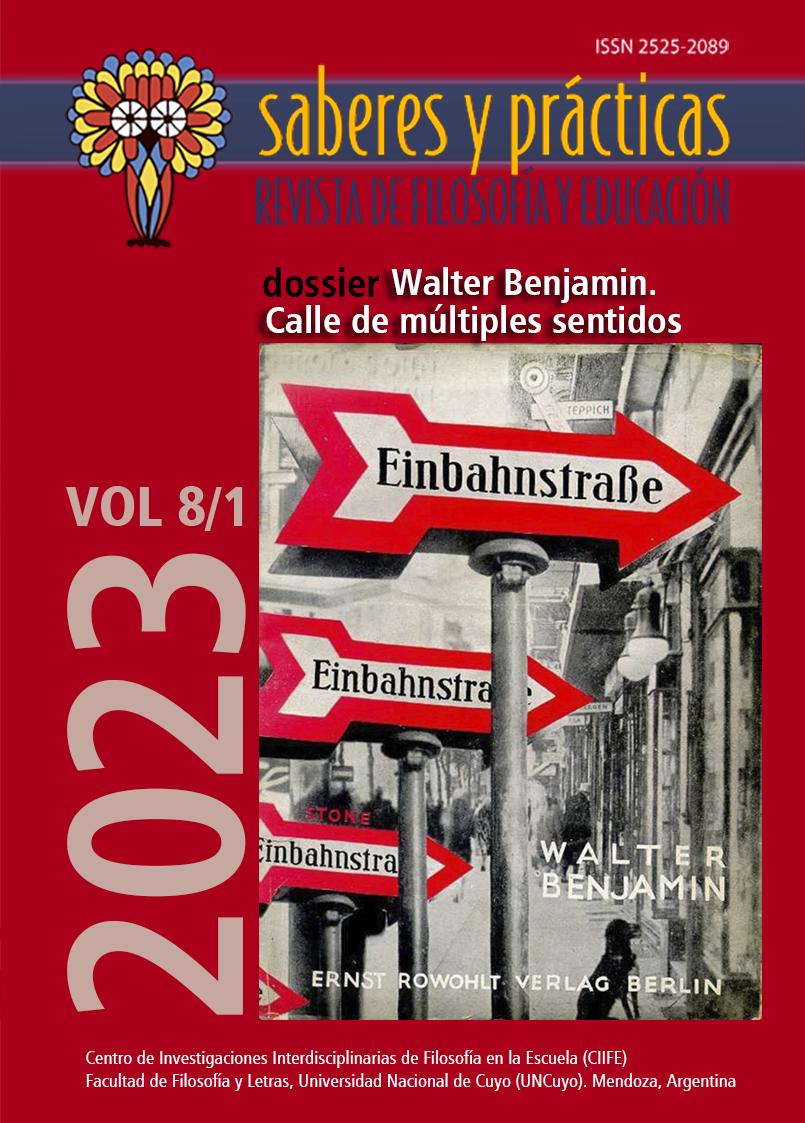Figuras de la desfiguración
El jorobadito y su círculo familiar
DOI:
https://doi.org/10.48162/rev.36.097Palabras clave:
desfiguración, Teoría crítica, Walter Benjamin, Franz Kafka, mesianismoResumen
"La desfiguración es la forma que adoptan las cosas en el olvido", dice Walter Benjamin en su famoso ensayo sobre Franz Kafka. El mundo de la desfiguración alberga todo aquello que, excluido del orden social y lingüístico y olvidado por nosotros, ha sido desechado como inútil, sobrante, inclasificable y que, sin embargo, sobrevive al orden intencionado y orientado a objetivos. Este residuo, precisamente porque no se puede conceptualizar, siempre ha producido su propio mundo de imágenes en la literatura, la música, en definitiva, en la imaginación humana. En este artículo, rescato la idea de la desfiguración de Walter Benjamin como clave de interpretación de este círculo de figura. Los habitantes de este mundo de la desfiguración, traviesamente se esconden en los rincones ocultos de nuestro orden doméstico. Son extraños y ajenos, inquietantes como algo que una vez fue nuestro y ahora está excluido. Lo que tienen en común es que se niegan a hablar, que se sustraen al agarre del concepto, que no se les puede inmovilizar, que despiertan culpa y vergüenza y que -quizá porque no viven, sino que a lo sumo sobreviven- no pueden morir. Como revoltosos y fantasmales cambia-formas, no nos dan tregua, exigen atención y desafían nuestro pensamiento, y sugieren que sin ellos no será posible una vida reconciliada.
Descargas
Citas
Adorno, T. W. (1964). Minima Moralia – Reflexionen aus dem beschädigten Leben. Suhrkamp.
Aichinger, I (2021 [1976]): Hemlin, in: Schlechte Wörter. Fischer, Frankfurt am Main.
Benjamin, W. (1998): Franz Kafka, en: Iluminaciones IV. Para una crítica de la violencia y otros ensayos. Editado por Eduardo Subirats; traducido por Roberto Blatt. Taurus,133-161.
Benjamin, W. (1982). Infancia en Berlín hacia 1900; traducción Klaus Wagner. Alfaguara.
Benjamin, W. (1985): Phantasie, in: Benjamin, Walter: Gesammelte Schriften, Band VI, Fragmente versmischten Inhalts, Autobiographische Schriften. Suhrkamp.
Buci-Glucksmann, C. (1984). Walter Benjamin und die Utopie des Weiblichen. VSA Verlag.
DWDS (Digitales Wörterbuch der deutschen Sprache) (2023). ent-“, <https://www.dwds.de/wb/ent- >, último acceso 14. 4. 2023
Freud, S. (1989 [1919]). Das Unheimliche, in: Freud, Sigmund: Studienausgabe. Bd. 4, Fischer.
Graf, S. (2022). Como el papel secante con la tinta – La teología inversa de Walter Benjamín Theodor W. Adorno. Editorial Gedisa.
Liska, V. (2002). Odradeks Schwestern, in Ecker, G.; Breger, C.; Scholz, S. (ed.). Dinge. Medien der Aneignung, Grenzen der Verfügung. Königsberg, Ts.
Perrier, F. (2009). Vorwort, in: Palmier, Jean-Michel: Walter Benjamin – Lumpensammler, Engel und bucklicht Männlein. Ästhetik und Politik bei Walter Benjamin. Suhrkamp, Frankfurt am Main.
Kafka, F. (2003): Las Preocupaciones de un padre de familia. En: Kafka, Franz: Cuentos completos, traducido por José Rafael Hernández Arías; Valdemar.
Khatib, S. (2013). 'Teleologie ohne Endzweck'. Walter Benjamins Ent-stellung des Messianischen. Tectum Verlag.
Schafroth, Heinz F. (1981). “Hinter Pritzwalk und Privas”. Die Topographie des Privaten im Werk Ilse Aichingers, in: Über Ilse Aichinger, Schweizer Monatshefte 61 (1981).
Spengler-Axiopoulos, B.; Wesener, S. Steht ein bucklicht’ Männlein da“- von Oskar, Zwerg Nase, dem Däumling und anderen kleinen Gestalten. Der Zwerg in der Literatur; contribucion de radio. https://assets.deutschlandfunk.de/FILE_ed3bb2028200dad5d3fbbe9f076c7eb8/original.pdf (último acceso 20 de abril 2023)
Publicado
Cómo citar
Número
Sección
Licencia
Derechos de autor 2023 Stephanie Graf
Esta obra está bajo una Licencia Creative Commons Atribución-NoComercial-CompartirIgual 2.5 Argentina.
Los/as autores/as que publican en esta revista están de acuerdo con los siguientes términos:
1. Los/as autores conservan los derechos de autor y garantizan a la revista el derecho de ser la primera publicaci´´ón del trabajo bajo una licecncia Creative Commons Atribución-NoComercial-CompartirIgual 2.5 Argentina . Por esto pueden compartir el trabajo con la referencia explícita de la publicación original en esta revista.
2. Saberes y prácticas permite y anima a los autores a difundir la publicación realizada electrónicamente, a través de su enlace y/o de la versión postprint del archivo descargado de forma independiente.


































